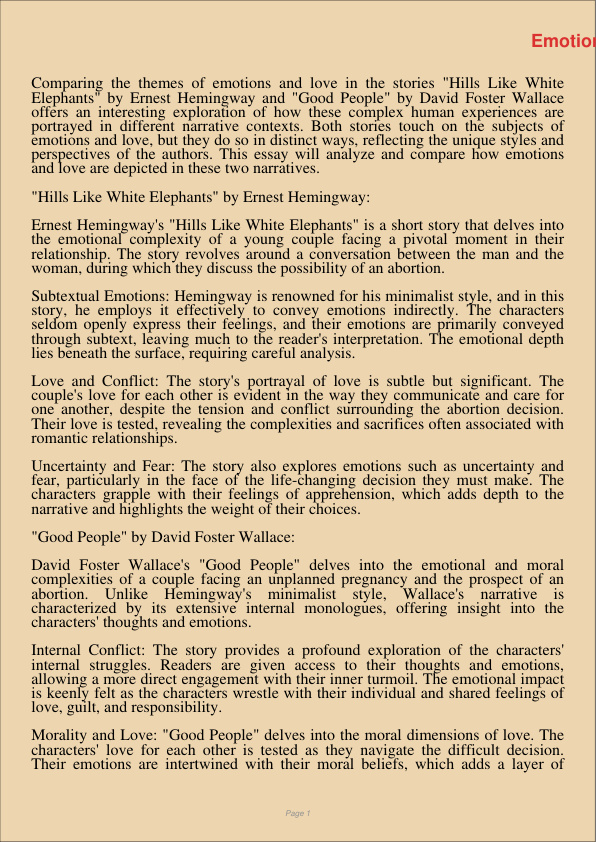Emotions And Love In The Stories Hills Like White Elephants And Good People
Jan 12, 2024
hills like white elephants
good people
Environmental Studies
Sociology

Comparing the themes of emotions and love in the stories “Hills Like White Elephants” by Ernest Hemingway and “Good People” by David Foster Wallace offers an interesting exploration of how these complex human experiences are portrayed in different narrative contexts. Both stories touch on the subjects of emotions and love, but they do so in distinct ways, reflecting the unique styles and perspectives of the authors. This essay will analyze and compare how emotions and love are depicted in these two narratives.
“Hills Like White Elephants” by Ernest Hemingway:
Ernest Hemingway’s “Hills Like White Elephants” is a short story that delves into the emotional complexity of a young couple facing a pivotal moment in their relationship. The story revolves around a conversation between the man and the woman, during which they discuss the possibility of an abortion.
Subtextual Emotions: Hemingway is renowned for his minimalist style, and in this story, he employs it effectively to convey emotions indirectly. The characters seldom openly express their feelings, and their emotions are primarily conveyed through subtext, leaving much to the reader’s interpretation. The emotional depth lies beneath the surface, requiring careful analysis.
Love and Conflict: The story’s portrayal of love is subtle but significant. The couple’s love for each other is evident in the way they communicate and care for one another, despite the tension and conflict surrounding the abortion decision. Their love is tested, revealing the complexities and sacrifices often associated with romantic relationships.
Uncertainty and Fear: The story also explores emotions such as uncertainty and fear, particularly in the face of the life-changing decision they must make. The characters grapple with their feelings of apprehension, which adds depth to the narrative and highlights the weight of their choices.
“Good People” by David Foster Wallace:
David Foster Wallace’s “Good People” delves into the emotional and moral complexities of a couple facing an unplanned pregnancy and the prospect of an abortion. Unlike Hemingway’s minimalist style, Wallace’s narrative is characterized by its extensive internal monologues, offering insight into the characters’ thoughts and emotions.
Internal Conflict: The story provides a profound exploration of the characters’ internal struggles. Readers are given access to their thoughts and emotions, allowing a more direct engagement with their inner turmoil. The emotional impact is keenly felt as the characters wrestle with their individual and shared feelings of love, guilt, and responsibility.
Morality and Love: “Good People” delves into the moral dimensions of love. The characters’ love for each other is tested as they navigate the difficult decision. Their emotions are intertwined with their moral beliefs, which adds a layer of complexity to their love.
Existential Angst: Wallace’s story delves into deeper existential questions, such as the characters’ search for meaning and their place in the world. The emotional weight of their situation is intensified by their reflections on their past, their faith, and their potential futures.
In conclusion, both “Hills Like White Elephants” and “Good People” explore the themes of emotions and love in the context of life-altering decisions. While Hemingway relies on subtext and minimalism to convey emotions indirectly, Wallace provides a more explicit portrayal of internal conflicts and moral dilemmas. These different narrative approaches offer distinct but equally compelling insights into the complexity of human emotions and the challenges of love when facing critical choices.